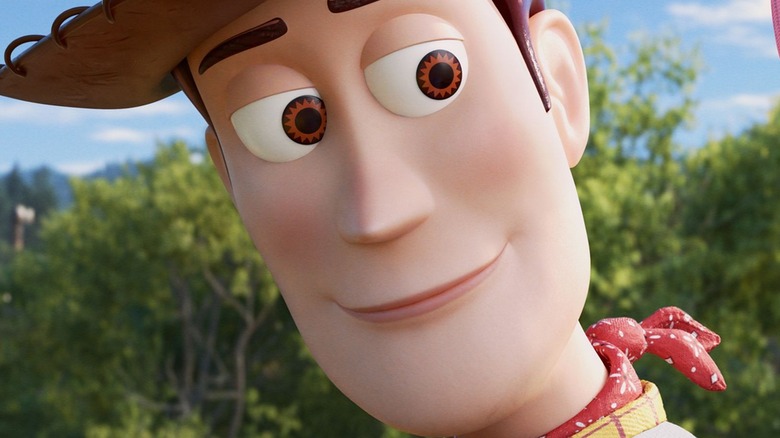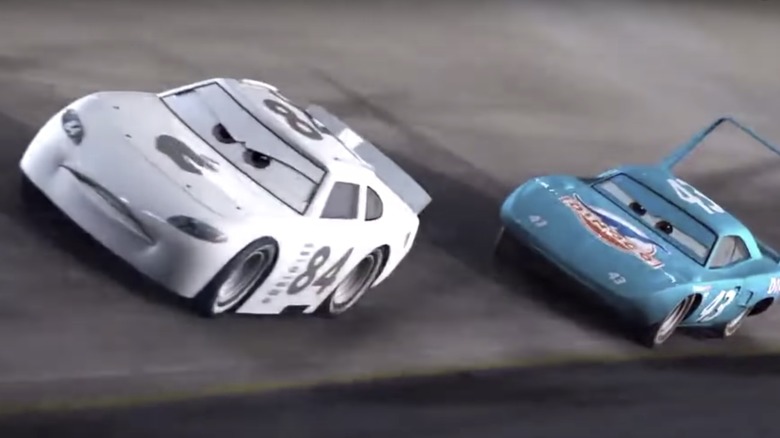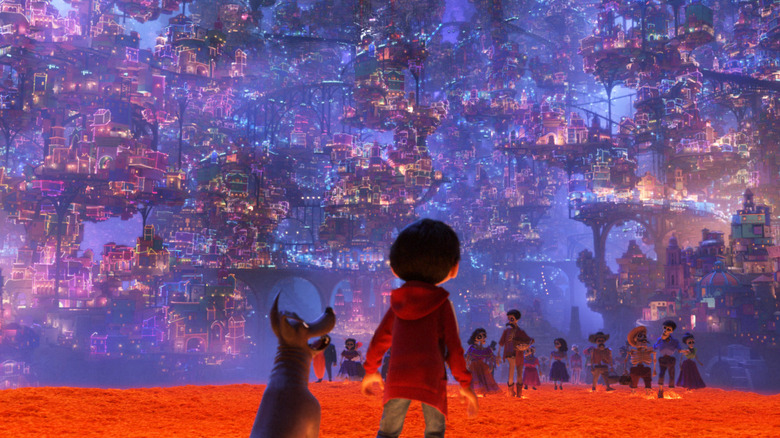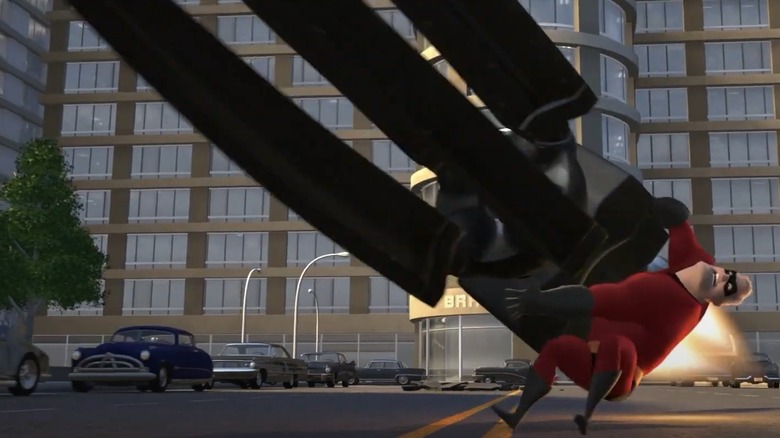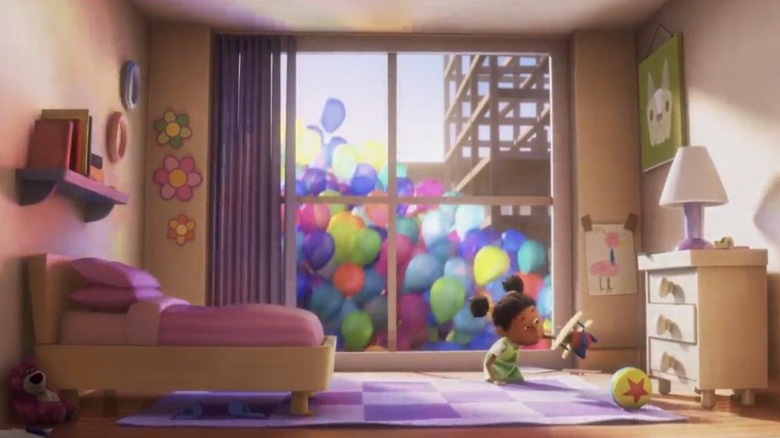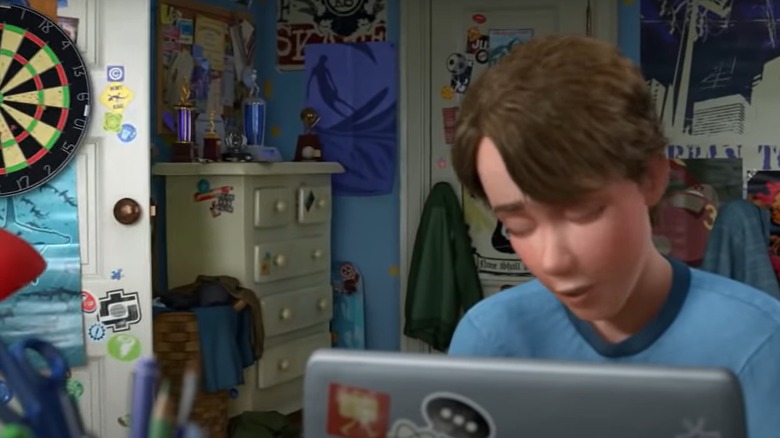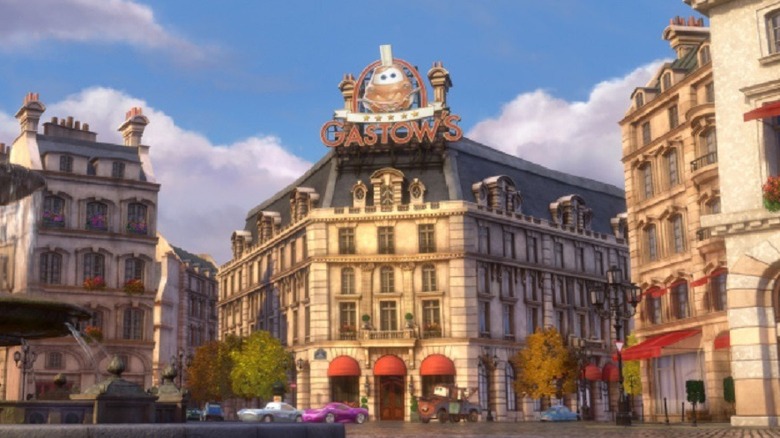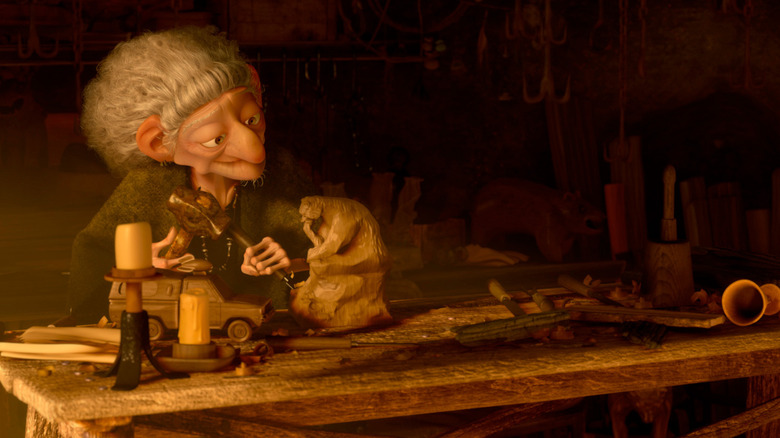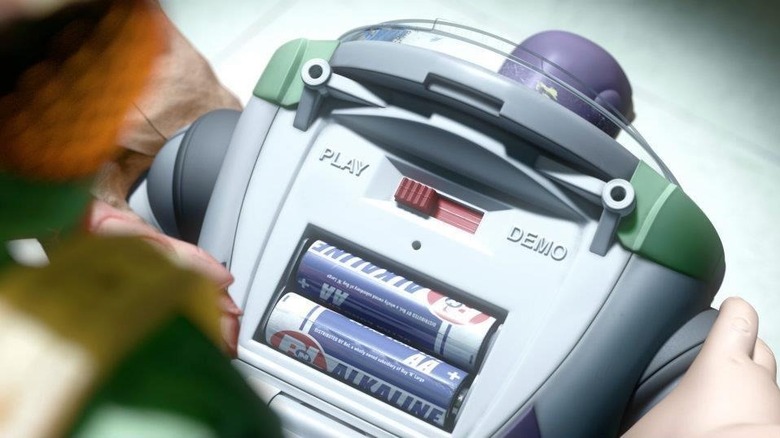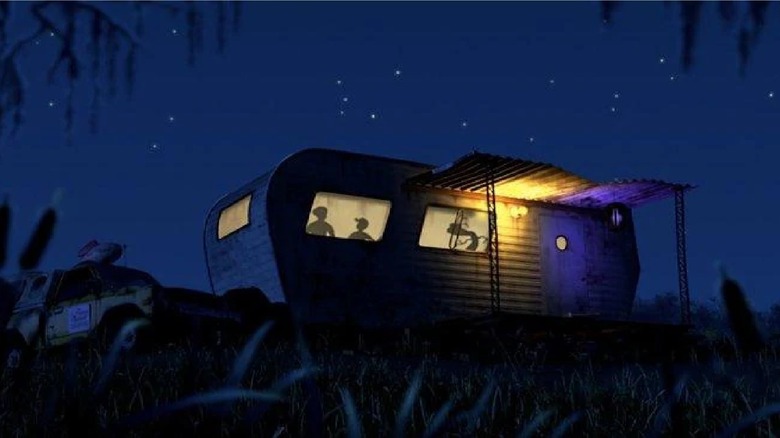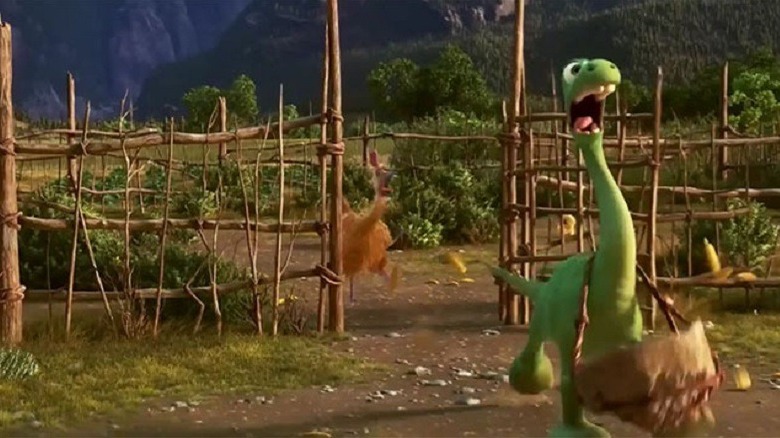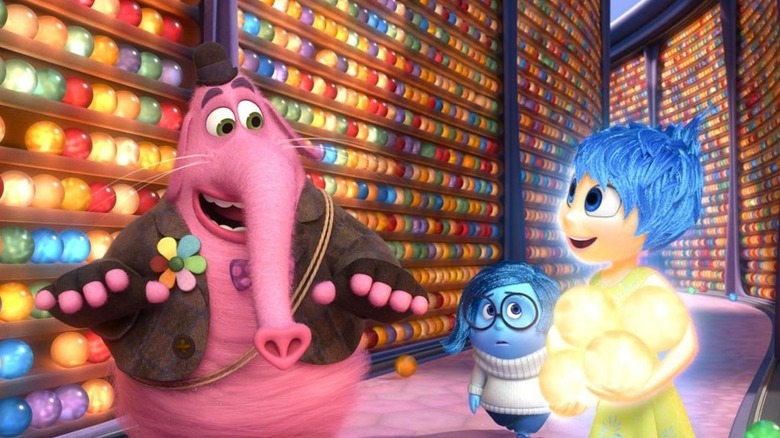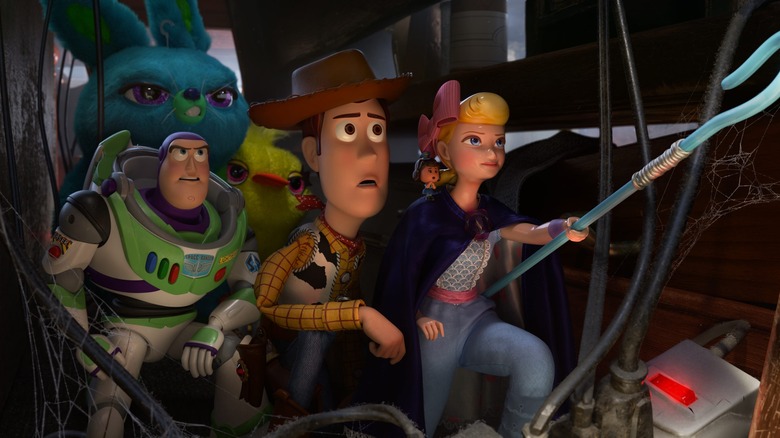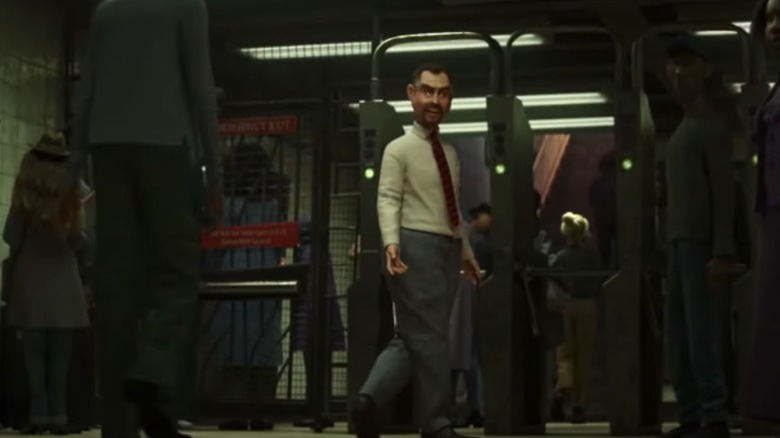The Most Paused Pixar Movie Moments
Sometimes, movies just require you to pause. Sure, the ideal viewing experience, as enforced by theatrical exhibition, is to blaze through the film, bathroom breaks be darned! But watching movies in the comfort of your own home, it's inevitable that something will cause you to pause what you're watching. Sometimes, this is due to life getting in the way, but other times, it's simply so you can appreciate the film. After all, movies are capable of instilling powerful emotions in us, delivering evocative imagery, and treating us with delightful visual gags. And sometimes, it's really rewarding to pause and appreciate what a film has just accomplished.
This is especially true when we're talking about Pixar movies. The incredible gems produced by this animation company have generated countless moments that require you to press pause and absorb what just happened on your screen. This can be due to a variety of feats, including delivering powerful emotional moments or simply the presence of an Easter egg that requires you to freeze the movie to find it. Whatever the reason may be, the most paused moments in the history of Pixar's filmography allow us to appreciate the various artistic feats of one of the world's most beloved animation studios.
Cars features an automobile tribute to Apple
In keeping with actual NASCAR vehicles, the various racers that Lightning McQueen competes against in the "Cars" movies all have distinctive brands on them. The vast majority of these are for fictitious companies such as Re-Volting or Leakless. However, a noticeable exception can be seen in a handful of shots in the original "Cars," as one of the racers is graced with what's clearly an Apple logo, complete with the color scheme associated with the company's iMac computers.
The racer, simply known as Mac iCar, isn't just shouting out a familiar brand. It's also a nod towards Steve Jobs, who helped save Pixar from dire financial straits in the early 1990s and who eventually sold the company to Disney in 2006. For all his contributions to the very existence of the studio, it's no wonder various tips of the hat towards Jobs and his works have slipped into Pixar's movies, including this particular racecar.
Arriving to the Land of the Dead in Coco
The first 20 or so minutes of "Coco" wow us with its animation, but that impressive nature comes from how well the visuals replicate reality. The animators at Pixar do incredible work rendering the village Miguel calls home with textures so tangible that it feels like you can reach right out and touch them. Emphasizing a sense of realism in this section of the film pays off big time once "Coco" shifts into a more fantastical setting when Miguel arrives in the fabled Land of the Dead.
Here, the level of detail and bright colors on display will require any viewer to pause the frame to make sure they're not missing anything. The screen is rich with obvious care and craft right down to the tiniest lantern and street corner. Through all that intricate detail, the Land of the Dead seems like the kind of place that could only exist in myths passed down from one generation to the next. The mind staggers with just how many streets and houses are contained here, and the possibilities for grand adventures seem truly limitless. It's a sequence that would already prove impressive in any context, but the story structure of "Coco" ensures the first glimpse of the Land of the Dead resonates as dazzling enough that you need to stop and take a moment to appreciate its splendor.
Doc Hudson shows up in The Incredibles
The finale of "The Incredibles" features a lot of endearing faces, including those belonging to the titular family, chill superhero Frozone, and even animated cameos from Frank Thomas and Ollie Johnston – the two last surviving members of Walt Disney's Nine Old Men. But one cameo viewers might miss if they blink comes when Mr. Incredible is clutching the severed hand of the Omnidroid and preparing to launch it into the deadly robot.
As our hero attempts this difficult task, on the left side of the screen, viewers can spot the automobile mold of Doc Hudson, a character voiced by Paul Newman in "Cars." Though missing those eyeballs he'd have in future appearances, the vehicle is unmistakably Doc. It's an appearance that continues the Pixar trend of having a character from a future movie make a quick cameo appearance, and it's a nice little Easter egg hidden in a truly incredible action scene.
Up features the first appearance of Lotso
One of the most memorable sequences in the 2009 Pixar feature "Up" concerns Carl Fredricksen unleashing a swarm of balloons over his house and beginning to soar towards Paradise Falls. On his way, he begins to see sights he never would've dreamed of. For the first time in his life, he's able to look down upon the rows of houses and businesses that once surrounded his tiny domicile. And for the people on the ground, the rare sight of a house soaring through the sky provides its own sense of unparalleled wonder.
Among those in awe of Fredricksen's flying home is an unnamed little girl who's playing in her room when, suddenly, that swarm of balloons rises next to her window. As she races to get one last look at the house floating upwards, moviegoers will see their own unexpected but wonderful sight. Lying against the wall of this girl's bedroom is none other than Lotso, the eventual villain of "Toy Story 3." Considering that "Up" was released a little over a year before "Toy Story 3," this was the first time moviegoers ever got to see a glimpse of that Strawberry-scented character. It may not be as glorious of a vision as the mountains of Paradise Falls, but this debut of appearance of Lotso is still its own kind of wonderful sight.
Toy Story 3 nods to the canceled Newt
Most Pixar Easter eggs reference movies that have already come out or are on the horizon. In the case of "Toy Story 3," though, there's a pretty unique exception. In Andy's room, we spot an Easter egg for a high-profile Pixar film that actually never got made. This quick gag comes in the form of a road sign sticker that reads "Newt Xing," accompanied by the image of a small lizard. (Look on the back of Andy's door.) And as diehard Pixar fans know, this is a reference to a now-canceled film entitled, you guessed it, "Newt."
Once set to be the feature-length directorial debut of Gary Rydstrom, "Newt" was the tale of the last two newts on Earth being forced to fall in love to save their species. The flick was once set for release in 2012, but it was revealed to be canceled just a month before "Toy Story 3" hit theaters. The reasoning for this was due to the film's unintended similarity to the 2011 feature "Rio," as well as general story problems with the production. While "Newt" never got to see the light of day, it does live on, at least in a way, through this "Toy Story 3" Easter egg.
Press pause to spot a familiar Parisian sight in Cars 2
"Cars 2" is a Pixar sequel that takes Lightning McQueen and Mater to international locations they've never traveled to before. Unlike these automobiles, though, the artists of Pixar actually had explored some of these territories in prior movies. For example, one scene takes Mater and super spy Finn McMissile to Paris, France, a location never seen in the "Cars" universe but one that was the backdrop of the 2007 Pixar movie "Ratatouille."
To reference the fact that Pixar had been to the City of Lights before, one of the most important buildings of "Ratatouille" — the restaurant Gusteau's — reappears here with a car-themed twist. Like so much in the "Cars" universe, this eatery has now been cheekily renamed to an automobile-themed pun. In a montage of sights found in this vehicle version of Paris, the camera briefly lingers on a restaurant named Gastow's. The film never returns to this location, so the viewer is deprived of the opportunity to see automobile versions of "Ratatouille" characters like Linguini. Still, any time Pixar can remind viewers of the existence of one of their most beloved motion pictures, it's a reason to take notice.
The Pizza Planet truck sneaks into Brave
When "Brave" was first announced, an understandable question emerged over how the film would work in that Pixar staple, the Pizza Planet Truck. Since "Brave" was the first Pixar movie to exist in a time before the invention of automobiles, it was puzzling to imagine how the feature would incorporate this vehicle — one that's appeared in each and every one of Pixar's movies.
It turned out there was a fantastical solution to working this truck into the film. When Merida enters the witch's hut, she see's this lady has been working hard on a series of wood carvings. And right next to the witch, sitting on a table, is a wood carving of none other than the Pizza Planet Truck. While "Brave" didn't feature any characters taking a joyride in that constant Pixar fixture, it still found an organic way to work it into the movie, even if viewers will have to reach for the pause button to clearly make it out.
The return of Buy n Large in Toy Story 3
The Buy n Large corporation in "WALL-E" is shown to be so big that it helped cause the collapse of the Earth itself. It's an ominous warning of what happens when we give a single company too much power. The extensive tendrils of this corporation have been reinforced in other Pixar projects, which have frequently reused the Buy n Large logo as a go-to image when some random item needs a big brand to hail from.
In the case of "Toy Story 3," it's shown that Buy n Large does more than just develop robots and hoverchairs. When Buzz Lightyear's back is popped open, the viewer sees that he's powered by very special Buy n Large Alkaline batteries. It's a delicate reference to "WALL-E" that doesn't prove distracting. Viewers who may have forgotten about this company or never seen "WALL-E" won't even notice its passing presence in "Toy Story 3." For those who do catch it, though, it's a clever way to remind audiences of one of Pixar's most acclaimed motion pictures.
This Monsters Inc. location looks kinda familiar
At the end of "Monsters Inc.," lovable Sulley tosses the villainous Randall through a door into an unknown location. But while Mike and Sulley never find out what happened to their adversary, audiences get to see exactly where Randall went.
Viewers familiar with previous Pixar movies will immediately recognize Randall's new digs. He's landed in the trailer home that was briefly glimpsed in "A Bug's Life." This trailer appeared in the 1998 film as being right next to a bustling city inhabited by insects, as well as being the backdrop to a memorable gag involving two flies and a deadly bug-zapper. In "A Bug's Life," the interior inhabitants of this location are never seen, but that all changes with this 2001 Pixar feature.
In "Monsters Inc.," the human owners of the trailer home are revealed through voice-over and silhouette, with one of the residents seeing Randall and thinking he's "a gator" that's somehow gotten into their domicile. This inspires another member of the home to break out a shovel and repeatedly bonk the lizard-like baddie over the head. Sure, it's a brief sequence, but watching Randall get his comeuppance in a familiar Pixar locale is endlessly entertaining.
How A113 showed up in The Good Dinosaur
When "The Good Dinosaur" hit theaters, many wondered where the folks at Pixar might hide one of their regular Easter eggs — the iconic A113, a reference to a crucial classroom at CalArts where many Pixar animators attended. Given that its characters were mostly prehistoric dinosaurs with no conception of numbers, it was unknown how the filmmakers would drop in this visual gag.
But the Easter egg, like life in the "Jurassic Park" movies, found a way into "The Good Dinosaur." It emerges in a scene where Arlo goes to check on the plants on his family's farm. These crops are contained in a patch surrounded by a wooden gate made out of sticks, some of which spell out A113. It's only on-screen momentarily, but if you've got good eyesight and you're willing to scour the frame, you too can pick up on how Pixar managed to work a distinctly modern Easter egg into the past.
You'll have to press pause after Bing Bong's death
You'd lose count if you tried to list off all the emotionally brutal Pixar moments that inspired adults to shed lots of tears. Dating back to the "When Somebody Loved Me" sequence in "Toy Story 2," Pixar has become a master of turning a bunch of computer-generated pixels into something that can make any grown-up weep. Few times has this talent been as obvious as the demise of imaginary friend Bing Bong in "Inside Out."
It's a sequence that occurs as Joy and Bing Bong attempt to escape the Memory Dump, lest they be permanently forgotten by Riley. In trying to leave, Bing Bong realizes that his wagon won't be able to carry both him and Joy. In a moment of quiet self-sacrifice, this imaginary friend plunges out of the vehicle, allowing it to soar out of the Memory Dump and take Joy to safety. Make sure you've got plenty of tissues because the scene gets even sadder when Bing Bong delivers his final words, telling Joy to "take [Riley] to the moon for me."
The pantheon of perfectly poignant Pixar scenes is deep, but it's rare to find one like the demise of this "Inside Out" character — a moment that requires viewers to pause the movie to collect their emotions.
A background gag in Toy Story 4 that could carry a tune
A critical setting for "Toy Story 4" is a pawn shop where the film's antagonist, Gabby Gabby, resides and eventually takes an adorable new character, Forky, as a prisoner. Not only is this setting an effective backdrop for Gabby to call home, but it also works as an opportunity to stuff the background with an avalanche of Pixar-themed Easter eggs. After all, pawn shops are absolutely stacked with random items, so why should this "Toy Story 4" location be any different?
Among the many possessions in this pawn shop that tie back into past Pixar movies, one that stands out is a vinyl record for songs by Ernesto de la Cruz. If that name sounds familiar, it's because it belongs to the musician that was at the heart of the plot of Pixar's 2017 feature "Coco." In that film, it was shown that, through duplicitous means, Cruz achieved such worldwide fame that his records were a common sight on any shelf, even ones belonging to a pawn shop in the world of "Toy Story."
How John Ratzenberger wound up in Soul
"Soul" featured several firsts for a Pixar title, including being the first entry in the company's canon to bypass a theatrical release altogether. But another significant detail is that it's the first film in the Pixar library to not feature a voice cameo from John Ratzenberger. Ever since he played Hamm in Toy Story, Ratzenberger has proven a constant presence across all of Pixar's films, voicing a character — even if it's just for one line — in each of their subsequent movies. Well, until "Soul," anyway.
Though that streak came to an end in 2020, that doesn't mean the "Cheers" alum was absent from the film. To compensate for his lack of a vocal appearance, "Soul" was the first Pixar movie to feature an animated version of Ratzenberger himself. A scene set on a subway station features the film's protagonist, Joe Gardner, racing by a crowd of people, which is where you can press pause and see the animated iteration of Ratzenberger. The character is only briefly on-screen, but he's definitely there, putting a creative new spin on a time-honored cameo.
